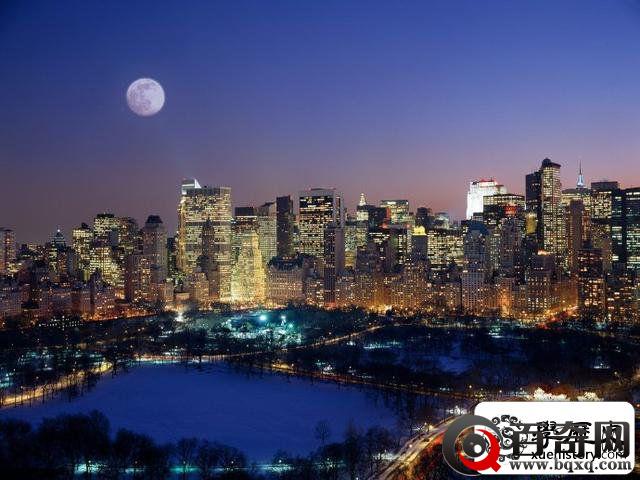
 微信扫码关注
微信扫码关注看新鲜资讯

 微信扫码关注
微信扫码关注作者:克里斯托夫(纽约时报专栏作家)

历史踏进了一个新千年,纽约成了全世界最重要的城市。甚至可以说是非官方的整个地球的中心。但在我们这些纽约客自我膨胀之前,中国中部已经没落的开封也许值得我们去探究一番。
开封,一座坐落于泥泞的黄河岸边的古老城市公元1000年曾是世界上最举足轻重的城市。如果你未曾听说过她的名字,那么对于美国人来说,这是一个颇有警示意义的提示就像文章上面的中文标题(注2)一样,这是越来越多的美国人即将开始学习的一种语言,“辉煌如过眼云烟”。
作为世界上唯一的超级强权国家,美国现在似乎把对全球的控制当作自己的一种权利。但如果你回望历史长河,显而易见,任何强权的存在都是极其短暂的,尤其是这种强权集中在单一的城市。
就我的观点,我认为追溯到公元前2000年前世界上最重要的城市,伊拉克的乌尔应算一个;公元前1500年前,可能是埃及的底比斯;公元前1000年前没有一个绝对的中心城市,如果有的话,黎巴嫩的西顿也算作是;公元前500年前,应该是波斯(现伊朗)的波斯波里斯;公元1年,罗马;公元500年,也许是中国的长安;公元1000年,中国的开封;公元1500年,可能是意大利的佛罗伦萨;公元2000年,纽约;公元2500年,上面列出的可能一个也不是。
今日的开封又脏又穷,甚至不是省会,小到连机场都没有。其凄惨的状况不禁令人扼叹命运的多变。11世纪时,它是中国宋朝的首都,人口逾百万而那时的伦敦只有15000人。现在珍藏于北京故宫博物院的一幅17英尺的古老画卷(即《清明上河图》编者注)显示了古都开封曾有的兴盛繁华。大街上人群熙熙攘攘,摩肩接踵,骆驼承载着来自丝绸之路的各色商品,茶馆和餐馆客似云来,车水马龙。
开封的名气吸引着来自世界各国的人们,包括许多的犹太人。直到今日,在开封依然有一些居民,虽然他们的长相和普通的中国人一样,但却自认为是犹太人,不吃猪肉。当我漫步在开封城时,我询问当地人,为什么一个曾经的国际中心城市会沦落到这步田地,言谈间,我感受到了他们对于纽约的羡慕。一个人还说他准备偷渡到美国去,大概需要花费两万五千美元(约合人民币20万元编者注)。但更多的当地人认为中国正走上振兴之路,将恢复在历史中扮演的世界领导者的角色。
"中国正在崛起,"市郊的一位青年农妇王瑞娜(音译)说,"我们只需要几十年,就可以赶上美国,甚至超越它。"她是对的。美国作为世界最大经济体已经持续一个多世纪,但是许多因素显示,若以购买力评价来衡量,中国在未来约15年内将超过我们。
所以纽约应该从开封那里学习些什么呢?必须学到的一课就是保证科学技术优势和健全的经济制度的重要性。历史上中国成为世界上最强盛的国家,依靠的正是先进的文明、领先于时代的贸易政策以及一系列技术革新,例如发明了铁制的犁,发明了印刷术以及纸币。但中国的封建社会发展到一定阶段后,开始轻视贸易和商业,在那之后的600余年时间里,经济停滞,人们的平均收入再没有提高过。第二堂课是要注意自满的危险。因为那时,中国开始习惯于自己是世界的中心,并认为无须向其他国家学习--这也是衰落的开始。
显然,美国也并没有意识到这两点。美国的国家经济管理体制过于松散,甚至无法应付农业补助津贴或长期的预算赤字。美国现在的科学技术水平依旧领先,但学校的数学和其他自然科学的教学水平只能算世界二流。而且美国人对世界其他国家兴趣的匮乏与目前中国人的努力、充满干劲以及果敢成为鲜明的对比,而这些精神正是今天中国重新回到世界最前线的原动力。
在黄河岸边,我遇到过一位名叫郝旺(音译)的7旬老农,他没读过一天书,他甚至不会写自己的名字---他的后人却完全不同。
关于开封的思考,刺激着我们努力提高我们的高科技水平、加强教育及制定有利于发展的政策。因为如果我们满足现状,即使辉煌伟大如纽约,也有可能像开封那样终结在哈德逊河岸。
英文原版:
From Kaifeng to New York,
glory is as ephemeral as smoke and clouds.
By Nicholas D. Kristof, The New York Times, 22 May 2005
As this millennium dawns, New York City is the most important city in the world, the unofficial capital of planet Earth. But before we New Yorkers become too full of ourselves, it might be worthwhile to glance at dilapidated Kaifeng in central China.
Kaifeng, an ancient city along the mud-clogged Yellow River, was by far the most important place in the world in 1000. And if you've never heard of it, that's a useful warning for Americansas the Chinese headline above puts it, in a language of the future that many more Americans should start learning, glory is as ephemeral as smoke and clouds.
As the world's only superpower, America may look today as if global domination is an entitlement. But if you look back at the sweep of history, it's striking how fleeting supremacy is, particularly for inpidual cities.
My vote for most important city in the world in the period leading up to 2000 B.C. would be Ur, Iraq. In 1500 B.C., perhaps Thebes, Egypt. There was no dominant player in 1000 B.C., though one could make a case for Sidon, Lebanon. In 500 B.C., it would be Persepolis, Persia; in the year 1, Rome; around A.D. 500, maybe Changan, China; in 1000, Kaifeng, China; in 1500, probably Florence, Italy; in 2000, New York City; and in 2500, probably none of the above.
Today Kaifeng is grimy and poor, not even the provincial capital and so minor it lacks even an airport. Its sad state only underscores how fortunes change. In the 11th century, when it was the capital of Song Dynasty China, its population was more than one million. In contrast, London's population then was about 15,000.
An ancient 17-foot painted scroll, now in the Palace Museum in Beijing, shows the bustle and prosperity of ancient Kaifeng. Hundreds of pedestrians jostle each other on the streets, camels carry merchandise in from the Silk Road, and teahouses and restaurants do a thriving business.
Kaifeng's stature attracted people from all over the world, including hundreds of Jews. Even today, there are some people in Kaifeng who look like other Chinese but who consider themselves Jewish and do not eat pork.
As I roamed the Kaifeng area, asking local people why such an international center had sunk so low, I encountered plenty of envy of New York. One man said he was arranging to be smuggled into the U.S. illegally, by paying a gang $25,000, but many local people insisted that China is on course to bounce back and recover its historic role as world leader.
China is booming now, said Wang Ruina, a young peasant woman on the outskirts of town. Give us a few decades and we'll catch up with the U.S., even pass it.
She's right. The U.S. has had the biggest economy in the world for more than a century, but most projections show that China will surpass us in about 15 years, as measured by purchasing power parity.
So what can New York learn from a city like Kaifeng?
One lesson is the importance of sustaining a technological edge and sound economic policies. Ancient China flourished partly because of pro-growth, pro-trade policies and technological innovations like curved iron plows, printing and paper money. But then China came to scorn trade and commerce, and per capita income stagnated for 600 years.
A second lesson is the danger of hubris, for China concluded it had nothing to learn from the rest of the worldand that was the beginning of the end.
I worry about the U.S. in both regards. Our economic management is so lax that we can't confront farm subsidies or long-term budget deficits. Our technology is strong, but American public schools are second-rate in math and science. And Americans' lack of interest in the world contrasts with the restlessness, drive and determination that are again pushing China to the forefront.
Beside the Yellow River I met a 70-year-old peasant named Hao Wang, who had never gone to a day of school. He couldn't even write his nameand yet his progeny were different.
Two of my grandsons are now in university, he boasted, and then he started talking about the computer in his home.
Thinking of Kaifeng should stimulate us to struggle to improve our high-tech edge, educational strengths and pro-growth policies. For if we rest on our laurels, even a city as great as New York may end up as Kaifeng-on-the-Hudson.
推荐阅读

极品校花与男友性爱流出 清纯靓丽床上风骚操到腿软 高潮颤
极品校花与男友性爱流出 清纯靓丽床上风骚 操到腿软 高潮颤挛抽搐 呻吟勾魂
2024-04-24

极品长腿黑丝御姐女神 魔鬼身材顶级美腿白虎粉逼操到腿软
❤️腰以下多是腿⭐ 顶级女神❤️极品长腿黑丝御姐女神 魔鬼身材顶级美腿 白虎粉逼操到腿软 天花板级女神
2024-04-24

高跟黑丝包臀裙 优雅气质 劲爆完美身材 梦中情人波涛胸涌 软
【优雅气质❤️白领御姐】高跟黑丝包臀裙 优雅气质 劲爆完美身材 梦中情人 波涛胸涌 软糯滚烫蜜道 美腿尤物操到腿软
2024-04-24

航空空姐,逆天长腿,仙女粉穴,和空姐做爱享受到的愉悦感
航空空姐,逆天长腿,仙女粉穴,和空姐做爱享受到的愉悦感果然比那些外围强多了!飞机上优雅的空姐被操的像条母狗
2024-04-24

酒店约炮白白嫩嫩的美女同事各种姿势干翻她的小嫩鲍⭐完美
酒店约炮白白嫩嫩的美女同事各种姿势干翻她的小嫩鲍⭐完美露脸
2024-04-24
推荐文章